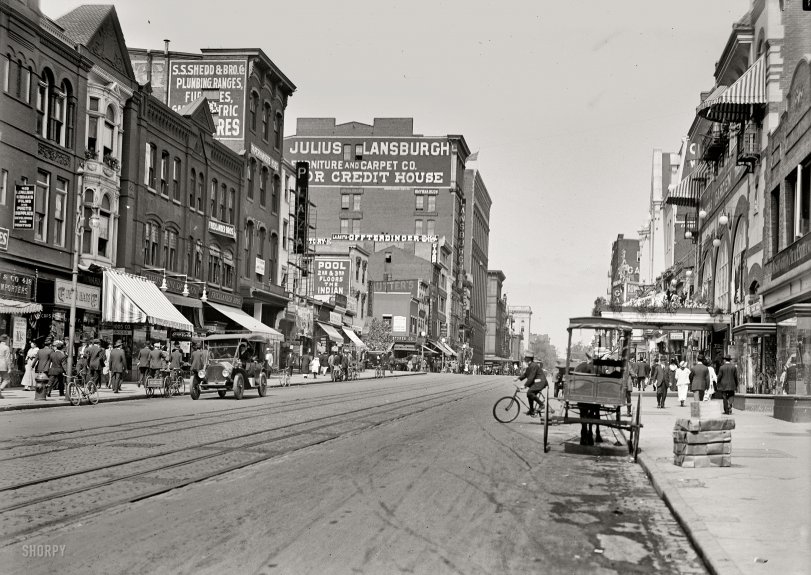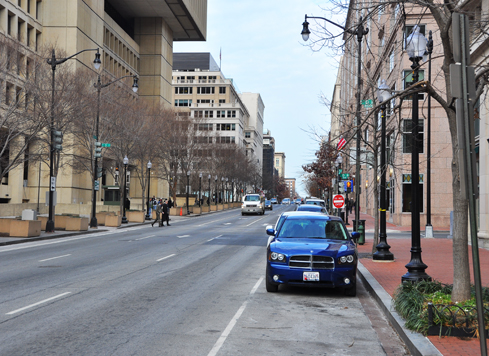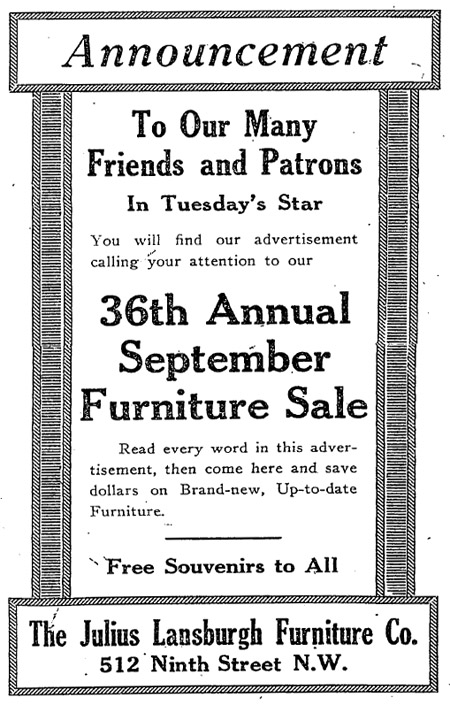


Framed or unframed, desk size to sofa size, printed by us in Arizona and Alabama since 2007. Explore now.
Shorpy is funded by you. Patreon contributors get an ad-free experience.
Learn more.

- Baldwin 62303
- Baldwin VO-1000
- Cold
- No expense spared
- Tough Guys
- Lost in Toyland
- And without gloves
- If I were a blindfolded time traveler
- Smoke Consumer Also Cooks
- Oh that stove!
- Possibly still there?
- What?!?
- $100 Reward
- Freeze Frame
- Texas Flyer wanted
- Just a Year Too Soon
- WWII -- Replacing men with women at the railroad crossing.
- Yes, Icing
- You kids drive me nuts!
- NOT An Easy Job
- I wonder
- Just add window boxes
- Icing Platform?
- Indiana Harbor Belt abides
- Freezing haze
- Corrections (for those who care)
- C&NW at Nelson
- Fallen Flags
- A dangerous job made worse
- Water Stop
Print Emporium
Ninth Street: 1915

Washington, D.C., 1915. "Street scene, Ninth Street N.W." Among the merchants represented here is department-store magnate Julius Lansburgh. View full size.
Early Ford
The forged front axle is the identifying feature. It is a Ford prior to the Model T. I'm leaning toward a 1911 Touring Car. The very basic design is reflected in Henry's Model B of 1905. That would be about the sixth Ford model produced.
+95
Below is the same view from December of 2010.

Not Ninth Street
The photo is of Seventh Street, NW. Look at the top center for the Lansburgh Dept Store signage.
[This is indeed Ninth Street. You're confusing the Lansburgh department store with the Lansburgh furniture store. - Dave]

Hair splitting
I think this is 9th street looking south, taken from the immediate left of the old Riggs building. It's going downhill sharply, and I remember the Gaiety theater being a few doors down from Riggs on the right when looking south.
Those buildings on the left house the Spy Museum.
[This is looking north, not south -- even-numbered addresses are on the left. The Spy Museum is on F Street. The buildings on the left have all been replaced by the J. Edgar Hoover Building. - Dave]
Kodak moment
I note on the left of the image a sign offering Kodak film and developing. Makes me think that someone from that business stepped out across the street to make an impromptu photo. What is amazing is that for the slow speed of the films (low sensitivity to light) in those days that they were able to get the motion of the pedestrians almost unblurred. It must have been a very sunny day to get away with a faster shutter speed to freeze the action.
[This photograph was made on glass, not film. - Dave]
Hitching weight
The triangular thing on the ground under the horse is probably a hitching weight, somewhat like this. Just heavy enough that the horse thinks it's tied up, but light enough to transport.
Actually trolley power came from underneath
Texcritic, the tracks aren't for horsecars. The Washington system was a cable car system with a continuously moving cable underground which each car would engage in order to move. See the "center rail" between the tracks? The gap in that center rail allowed the cars to grab the cable and move.
[Not quite. The streetcars here were electric. Although there was a traction line in Georgetown. - Dave]
Washington Trolleys
were electric by 1915. What looks like a third rail on the tracks is a slot, in which the power line was buried. The trolley cars had a pickup on a "plow" that projected down into the slot and made contact. That system stayed in use until trolley service was discontinued in the early 1960s.
Not horse drawn street cars
The street cars in downtown D.C. ran from an underground feed (see the slit midway between the rails). As you moved away from the downtown area they raised the trolley pole and switched to the overhead wires.
Horse Tether
That "anchor thing" on a leather strap was a steel weight to temporarily tether the horse, used on milk and bread wagons as well.
The Car
It would be interesting to know the make and year of the car on the left of the photo...it appears to be a right-hand drive. I've done some superficial Google images research and can't identify it. Early American cars were produced in RHD. Ford switched to left hand drive production in 1906 and Cadillac in 1916. What a great image....thanks Shorpy!!
Devil in the details
Another great Shorpy photo, teeming with robust urbanites, no doubt in early spring. Look at those women. New York's Fifth Avenue had nothing on them! This photo depicts the plethora of transportation modes available in cities in those days. We need to take a cue for our own times, though bringing back the horse could be problematic.
Ninth St NW
Dave, I think this is 400 block of Ninth Street NW looking north. A few of the businesses I have verified are:
- Dean Hats, 422 9th St - Benjamin D. Dean, proprietor
- Howard A French, 424 9th St - Indian Motorcycles
- Christiani Drug Store, 426 9th St
- Friedlander Bros, 428 9th St - Men's Suits
- S.S. Shedd & Bros, 432 9th St
- Plaza Theater, 434 9th St
- Offterdinger Cigars, 504 9th st - Henry T. Offterdinger, proprietor
On the right side of the street are Crandall's and Moore's Garden Theaters - seen in this Shorpy photo.
Wow, what detail!
Horse drawn (no overhead wires) trolley tracks. [The trolleys were electric. See above. - Dave]
Packages at far right perhaps reels of film? (in front of Washington Film Exchange). 1915 was the year of "Birth of a Nation" so who knows?
Sign for Smyrna rugs is seen 7 years in advance of the burning and slaughter of many citizens of Smyrna, now known as Izmir.
One of the best.
I actually think...
This is Ninth Street NW looking north. Just beyond the Lansburgh that's the old Riggs Bank building at the southwest corner of Ninth & F.
[You are correct! I have changed the caption accordingly. - Dave]
Horse anchor
What is that cone-like thing on the ground with a rope or something leading up to the horse. Is that some sort of anchor to make the horse stay put while the driver's inside? Kind of like the anchor of a boat? If not, the question still stands. What is that thing?
Advertising
I love the painted-on-brick ads. You only see faded ones nowadays - I wonder why they went out of fashion? Maybe they needed touching up too often.
I'm intrigued by the "Backward Season" sign at the importers' on the far left. Was Backward Season a widely-used term for something, or just their own little promotion name à la "Dollar Days?"
["Backward season" was, to judge from the clothing ads in the Washington Post archives, a term used in retailing to describe unseasonable weather in both spring and fall. It was certainly the occasion for a lot of sales. Its last use came in 1955. - Dave]
Fixed gear bikes
Notice that none of the bikes left leaning against the curb have locks. Imagine trying that today.
























On Shorpy:
Today’s Top 5